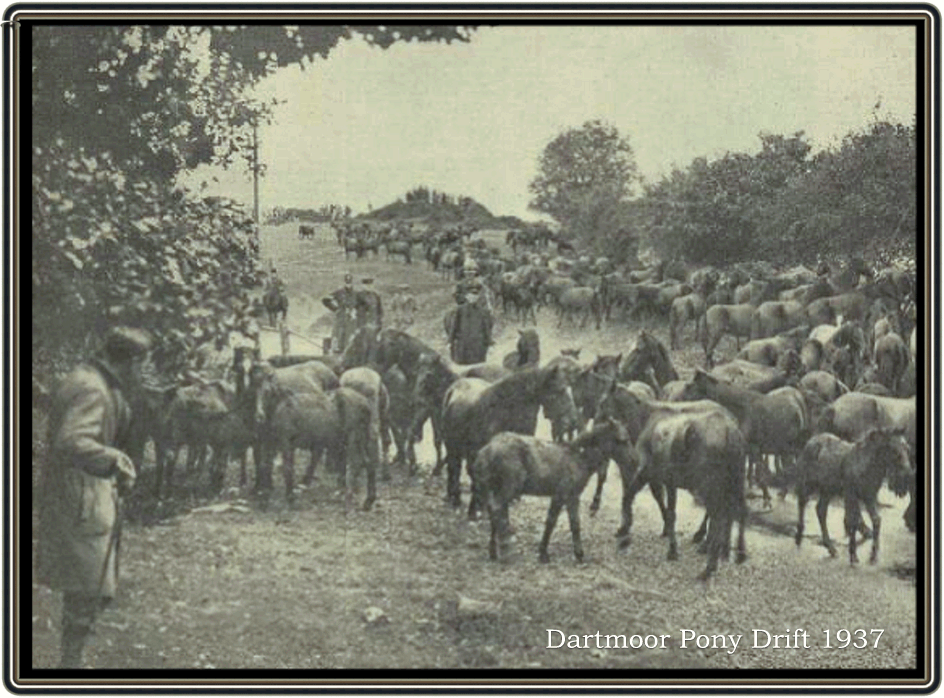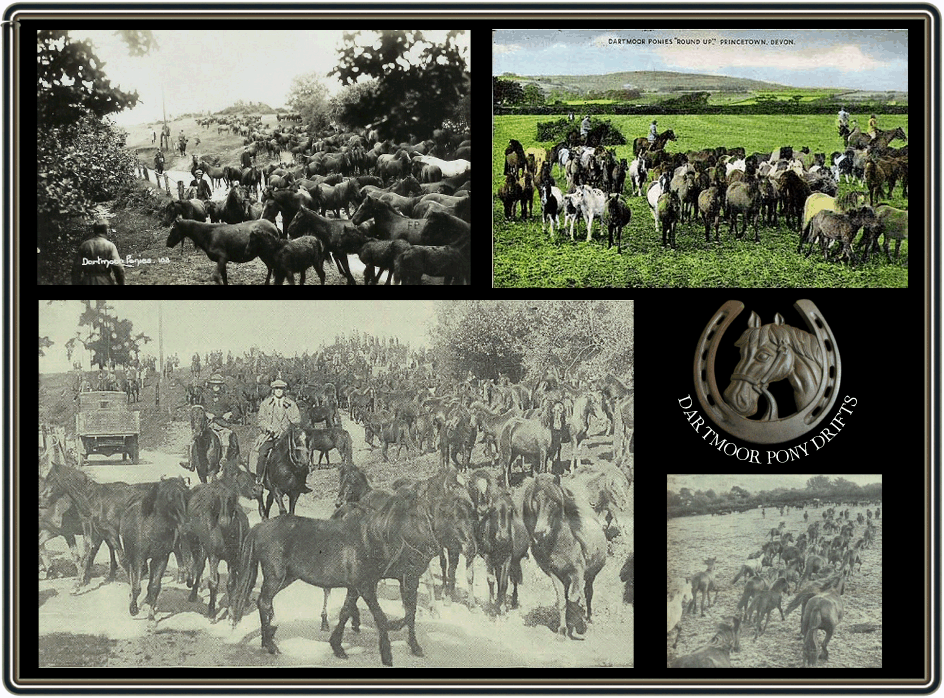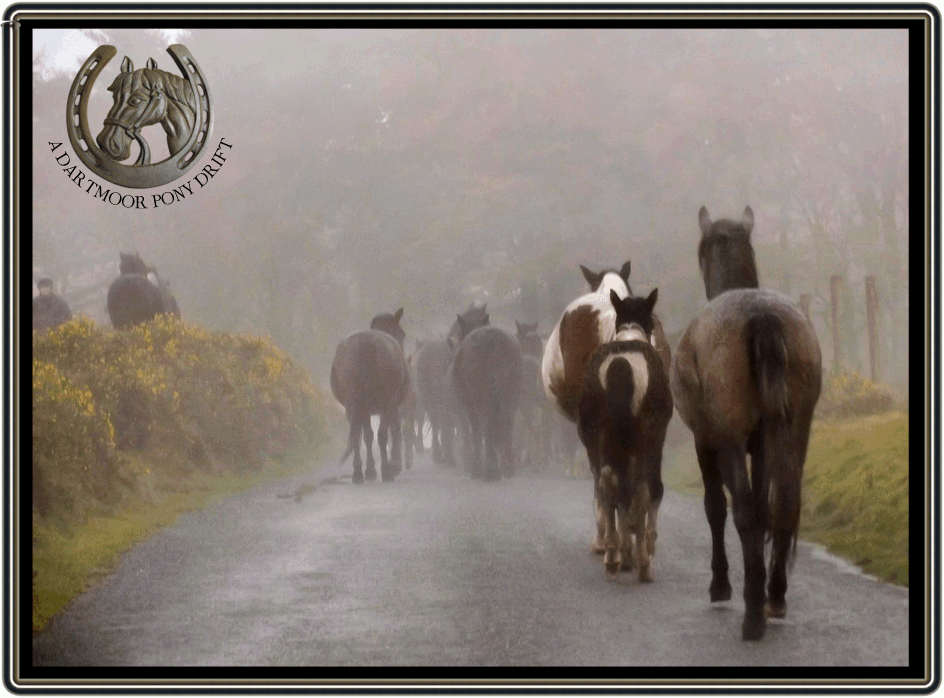
If you happen across a Dartmoor pony drift today you will see that in the main it’s an operation that consists of a combination of horsepower and mechanised vehicles such as quad bikes and trail bikes. However in days gone by there were a couple of vast differences, firstly the numbers of ponies rounded up were much larger and secondly the whole operation relied entirely on horse power. Having never witnessed one of the old roundups of say eighty years ago I was pleased to come across a newspaper report in the October 11th edition of the Western Morning News and Mercury describing a drift which took place in 1923. Hopefully you will agree that it must have been quite a spectacle to observe.
“All lovers of Dartmoor admire the groups of shaggy, sturdy ponies which are to be found in all parts of it, but it is not everyone who has the good fortune to be present at a “drift” in the annual round-up of the hardy little animals.
At the “drift” the separate owners claim their ponies and pay their due to the renter of the moor, and after selecting the most promising of the bunch to be sent to the pony sales, which are held in the autumn at Tavistock, Dousland, and other moor centres, the foals are branded and together with the remainder sent to roam the moors for another twelve months.
This year I attended my first “drift” which was held at Shaugh. My first intimation of what was taking place was from a waggoner, who, in response to my inquiry, said “the riders are up across the moors and there are a brave number o’ ponies but they ain’t come down yet mister.”
A little later this information was endorsed by a youth who was trimming the hedge by the side of the road, leading to Neal (Kneel Gate) moorgate. The ponies he said, would be down in a space of seconds. “There be millions of ’em mister,” he gravely told me, “leastaways thousands,” he added on second thought. “Look at ’em all up there.” Following the direction of his eyes, away on the moors a few hundred yards distant, could be seen masses of ponies with horsemen heading off any showing a disposition to stray.
Scrambling up the hedge I commanded a splendid view of the long winding lane and the distant moor. Here I was joined by a couple of a farm workers to whom the spectacle was an annual event. “Here they be,” one of them shouted, and I conjured up a wild, dashing, stampeding mass of ponies, but to my surprise two horsemen first appeared around the corner, one a lady in riding habit, the other a farmer. “That be Mr. Sellick, the moorman, and Miss Coryton.” one of them informed me. Behind those riders, heralding their approach by a chorus of shrill whinnies, came the ponies, a spectacle wonderful and unforgettable. They came at a quick , nervous little trot, the unshod hoofs making a curious pattering sound on the hard road. They came, not in a mass, but in groups numbering from three to four to large bodies of thirty or forty. Ponies light, ponies dark, lean and fat, tall and short, mothers who had lost their foals plaintively calling to their offspring, and long-legged, barrel-bodied youngsters whinnying plaintively to their missing parent.
Ever they came, and I watched fascinated and enthralled. The end of the procession was signalled by a body of horsemen, whose numbers ranged from sixty to seventy, men whose lives had been spent on the wide spaces of the moors, and whose mounts, sturdy, but swift and sure of foot, know the moors equally as well as their riders, and with them so many dogs equally at home in this wind-swept land.
Rounding the corner by Brownies Cross (Browney Cross) the procession ended abruptly at a gate, through which the ponies passed. Mr. Sellick, the moorman, stood at the entrance, and as the last little animal vanished he announced that 540 of them had been rounded up that day. It was the best drift, I was told, that they had had for many years.
Closing the gate of the corral, or “drift” field, Mr Sellick announced “that he was going down to the house to get something to eat,” and the mass of riders, after tethering their horses in the neighbouring field and orchard, followed his example, and adjourned to Brook Villa, Mr. Sellick’s residence, nestling cosily in a hollow at the foot of a steep hill.
There was method in this adjournment of events, for in the comparatively small enclosure the animals used the time to sort themselves out. Mothers searched and found their straying foals. Pals of twelve-month standing were reunited, and for a space the ponies were at rest.
Leaving the ponies for a space I wended my way to Brook Villa, for “drift day” is “open house” day… After luncheon, which the hungry riders were in the mood for, the venue once more changed to the “drift” field, where the scene was one of much animation. Here while the ponies rushed about, I had a little talk with Mr. Tregillus, of Horrabridge, a cousin of Mr. Sellick the “moorman” Mr. Tregillus, I found had been attending these “drifts” for more than fifty years, and is one of the oldest attendants at them. He proved a veritable mine of information.
It was from him that I learnt that these “drifts” take place annually at certain moorland centres. About 7 o’clock that morning, riders had started from a radius of between seven and nine miles from Sheepstor and Meavy, from Ringmoor and Widford (Wigford)Down, to mention a few places, all converging at the central meeting place at Cadover bridge. Each rider, as he encountered ponies rounded them up, and drove them to the meeting place. It is a task that need skilled horsemanship and a sure-footed mount, for the ponies do not take kindly to coercion, and many a wild dash for liberty led to a hard gallop on the part of the rider. Towards noon the actual round up has been generally accomplished. Mr. Tregillus mentioned that “folk did not get up as early as they used to nowadays. The drift did not commence until 7 to 7.30 am., but years ago they used to be up by 4 in the morning.
He explained that Mr. Sellick rented what is termed a quarter portion of the moor, and that all the riders were owners of the ponies, and in return for the right to allow the animals to use that portion of the moor for grazing purposes paid to the “moorman” a small annual sum in respect of each animal. With the exception of foals, or “suckers” as they are termed, each animal bears the brand of its owner. After running the moors for a twelvemonth, the mares are accompanied by their foals which at “drift” time are branded by their owners, so that every animal is automatically branded in the first year..
The present “drift” was the largest that has taken place for a number of years, but some time ago, when ponies were not as valuable as at present, more than 800 ponies have been rounded up. At this year’s round up, two ladies were present, Mrs Edwards and Miss Coryton. The latter lady, who is a daughter of the late Mr. W. Coryton, Master of the Dartmoor Foxhounds, is a regular attendant, and had been in the saddle with the riders since 8 a.m. Another interesting personality was a young law student, who was spending a holiday in the neighbourhood. Mr. Tregillus mentioned that this young fellow had ridden Magpie, a horse standing 17 hands, and which had run in the Grand National some three years ago.
The task of separating the ponies according to ownership now began, and to those who seek arduous physical exercise it is an occupation that can be recommended. The usual method is for a number of owners to band together and collect their ponies in a bunch at the side of the hedge. This sounds easy in theory but in practice it is something very different. A number, probably old stagers submitted to what was required of them exceedingly well, but the younger element who revealed surprising turns of speed chose any portion of the field but that in which they are wanted, and merry chases ensued – for the spectators and not the participants.
Whips cracked, men shouted, and all around was the rumble of countless hooves. Gradually skill and patience told their tale, and as afternoon advanced the groups of horses standing against the four hedges became larger and the number of unclaimed animals fewer.
By virtue of his position the animals owned by the “moorman” were collected nearest the gate, and after all owned by him had been separated, the gate was opened and they were driven into another field, this process being followed by each successive group of owners. After the animals had been taken away by their owners the youngsters were branded and a selection of the best was the made to forward to the sales. A good specimen will fetch anything from £15 to £20 I was informed. The remainder are then turned loose to roam the moors for another twelve months.
Occasionally animals of a strange brand wander into this portion of the moors, to be claimed by the “moorman” of the quarter to which they belong. Occasionally too, there may be unbranded animals of foals without parents. These became the perquisite of the “moorman,” who, however, at times distributes them to those of his tenants who have suffered losses in stock through sickness, death, or other causes.
I stayed until the sun had set over the hill and as I went out of the gate a bunch were grouped in the roadway, waiting for the signal that would lead them back to their own wild, native moors, or to take a longer journey into the pits of Wales, or whatever task their purchasers may deem them available for. So it comes that instead of, as many imagine, the Dartmoor pony being simply a wild, carefree rover of the moor, he has in front of him a very definite and sometimes chequered existence.“
If you would like to compare the above account of a drift which took place in the 1920s with a modern day equivalent then the Dartmoor Pony Trust have an excellent video of the 2005 drift which took place at Widecombe-in-the-Moor and can be viewed – HERE. It’s worth noting that if you use the UK Inflation Data then the £15 that the ponies were fetching in 1923 is the equivalent of £769.13p today?
 Legendary Dartmoor The many aspects past and present of Dartmoor
Legendary Dartmoor The many aspects past and present of Dartmoor



